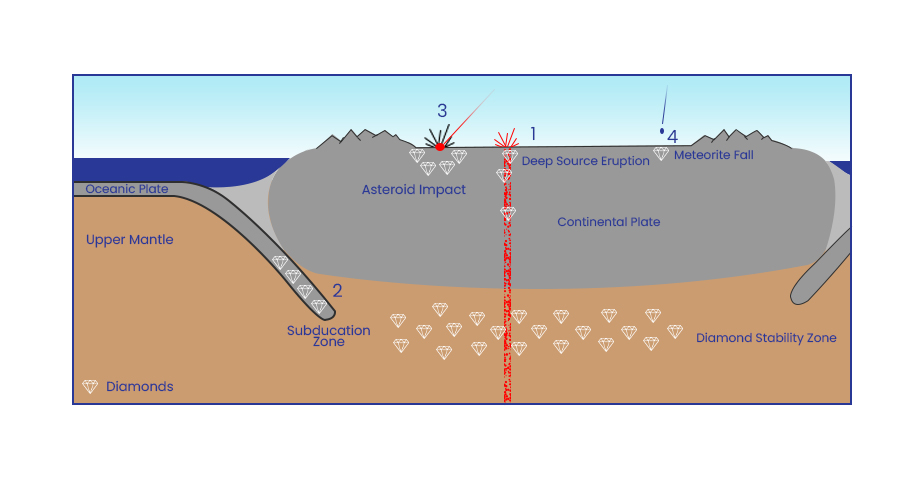How are diamonds formed in nature? Test your diamond knowledge!
Posted by Hari Krishna
May 20, 2022
Have you ever wondered how diamonds are formed?
What is the diamond formation process?
Are diamonds really made from coal? Don’t worry if you do not have any of the answers.
We will try our best to fulfill such concerns by taking our experts’ views.
Being one of the top diamond manufacturers in India, we try to gain and share knowledge of every little aspect of the diamond world.
So let’s get started with another topic!
Before we jump in, let’s first understand the scientific process of diamond formation.
Diamonds were founded in the 19th century in South Africa. They are formed deep within the Earth in an area called the mantle.
Here, intense pressure changes the molecular structure of carbon by crushing its atoms and forcing them into a whole new lattice-like structure.
Due to the extremity of pressure and temperature, this carbon becomes a diamond.
When the temperature rises to up to 1500 degrees Celsius and the pressure goes up to 50 kilobytes, carbon’s strongest form, ‘Diamond,’ is created!
Chemically, to form graphite, carbon atoms bond to three other carbon atoms in the 2D pattern.
At the same time, heat and pressure change this atomic structure and force carbon to make four bonds, which results in a stronger 3D pattern, forming a shiny beauty, the diamond!

We’ll explain all of them below, but you can also consider the above image for a better understanding.
1. Diamond Formation in the Earth’s Mantle
According to geologists, nearly all diamonds discovered in diamond mines were formed in the upper mantle and transported to the surface by a deep-source volcanic explosion.
Volcanic eruptions are thought to be responsible for the formation of kimberlite and lamproite pipes, which contain gemstones along with rough diamonds.
We know that the majority of diamonds are found in commercial mines, but they were created deep within the Earth’s mantle, about 150 kilometers beneath the surface.
Diamonds are formed in the upper mantle’s “diamond stability zone,” a high-pressure region with a temperature of more than 1,000 degrees Celsius.
Diamonds form and grow continuously down there, just as they have for billions of years.
The gems are brought to the surface of the Earth in large chunks of rock called xenoliths during a seismic event such as a volcanic eruption.
2. Diamond Formation in Subduction Zones
The second method of the diamond formation process is believed to form in “subduction zones,” areas in convergent boundaries, where tectonic plates that are constantly moving underneath the earth’s surface collide and cause one plate to push beneath the other.
Small rough diamonds formed in subduction zones grow at temperatures as low as 199 degrees Celsius, just 50 miles below the earth’s crust.
According to some studies, subducted seawater plays a role in the formation of diamonds in these zones, while others have discovered that these diamonds possess minuscule bits of oceanic crust.
Rocks that have traveled to and from subduction zones are extremely rare.
3. Diamond Formation at Impact Sites
Earth has been hit by a few asteroids at various times throughout its history.
When an asteroid collides, it creates extreme pressure and temperatures, which are ideal conditions for rough diamond formation. At several asteroid impact sites around the world, this process can be observed.
Diamonds have been discovered in meteor craters in Arizona and Siberia, Russia, where excavators discovered diamonds up to 13 millimeters in size at the Popigai Crater.
4. Diamond Formation in Space
Large amounts of nanodiamonds have been discovered in extraterrestrial bodies, according to NASA researchers.
These could have formed in outer space or in the mantle of other planets. These diamonds, however, are far too small to be used as diamond industrial abrasives, though they are still a fascinating find.
Contrary to what people assume, diamonds do not form from coal in any way.
A comparison of the age of Earth’s diamonds and the age of the earliest land plants is the most convincing proof that coal did not play a role in the formation of most diamonds.
Because coal is made up of the remains of terrestrial plants, and the oldest land plants are older than almost every diamond ever discovered, it’s easy to conclude that coal played no role in the formation of Earth’s natural diamonds.
Coal seams are sedimentary rocks that usually occur in horizontal layers, which adds to the flaws in this theory that coal doesn’t have anything to do with the diamond formation process!
Diamond source rocks are found in vertical layers alongside igneous rocks.
So, we hope you’re satisfied with our sayings on diamond formation.
Now let’s check how much you’ve actually learned and remembered. So be prepared for an interesting diamond quiz! Let’s get started!
A. 3
B. 4
C. 6
A. Upper Mantle
B. Middle Mantle
C. Lower Mantle
A. Xenoliths
B. Sedimentary
C. Kimberlite
A. Divergent boundaries
B. Transform boundaries
C. Convergent boundaries
A. Arizona
B. Popigai Crater
C. Siberia
A. ISRO
B. SpaceX
C. NASA
⟣ P.S: To verify your answers, visit this link: 🠮HK Diamond Quiz